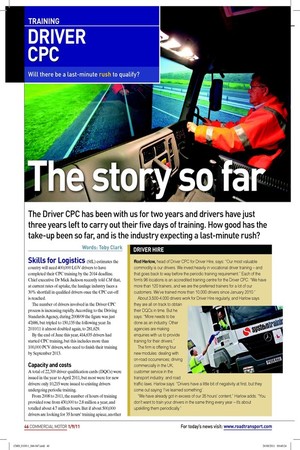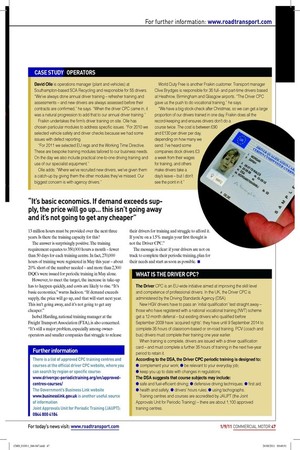The story so far
Page 41

Page 42

If you've noticed an error in this article please click here to report it so we can fix it.
The Driver CPC has been with us for two years and drivers have just three years left to carry out their five days of training. How good has the take-up been so far, and is the industry expecting a last-minute rush?
Words: Toby Clark Skills for Logistics (SfL) estimates the country will need 400,000 LGV drivers to have completed their CPC training by the 2014 deadline. Chief executive Dr Mick Jackson recently told CM that, at current rates of uptake, the haulage industry faces a 30% shortfall in qualiied drivers once the CPC cut-off is reached.
The number of drivers involved in the Driver CPC process is increasing rapidly. According to the Driving Standards Agency, during 2008/09 the igure was just 47,686, but tripled to 150,135 the following year. In 2010/11 it almost doubled again, to 281,629.
By the end of June this year, 414,635 drivers had started CPC training, but this includes more than 100,000 PCV drivers, who need to inish their training by September 2013.
Capacity and costs
A total of 22,319 driver qualiication cards (DQCs) were issued in the year to April 2011, but most were for new drivers: only 10,215 were issued to existing drivers undergoing periodic training.
From 2008 to 2011, the number of hours of training provided rose from 430,000 to 2.8 million a year, and totalled about 4.7 million hours. But if about 500,000 drivers are looking for 35 hours’ training apiece, another 13 million hours must be provided over the next three years. Is there the training capacity for this?
The answer is surprisingly positive. The training requirement equates to 350,000 hours a month – fewer than 50 days for each training centre. In fact, 270,000 hours of training were registered in May this year – about 20% short of the number needed – and more than 2,300 DQCs were issued for periodic training in May alone.
However, to meet the target, the increase in take-up has to happen quickly, and costs are likely to rise. “It’s basic economics,” warns Jackson. “If demand exceeds supply, the price will go up, and that will start next year. This isn’t going away, and it’s not going to get any cheaper.” Isobel Harding, national training manager at the Freight Transport Association (FTA), is also concerned. “It’s still a major problem, especially among owneroperators and smaller companies that struggle to release their drivers for training and struggle to afford it. If you’re on a 1.5% margin your frst thought is not the Driver CPC.”
The message is clear: if your drivers are not on track to complete their periodic training, plan for their needs and start as soon as possible. ■














































